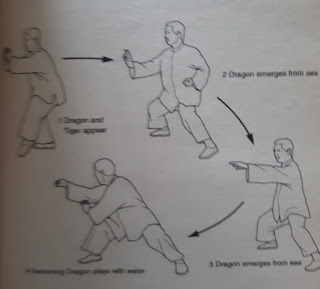Defense Form: Movement No. 6- Inward Knife Hand Strike

Hello, everyone.
We have arrived at the last movement in this kata. I don't remember seeing a knife hand strike in any katas of Okinawan Karate, but I know of 3 katas in Shotokan that feature this inward knife hand strike.
Kung Fu practitioners know about the knife hand strike, but I have not seen it used, except by Wing Chun exponents.
I have always loved knife hand strikes and started breaking wooden boards out of my own at an early age although neither of the two dojos at which I have studied taught breaking techniques. For me it just felt like the right thing to do. If you are a Karate student, you must have a karate chop. There was no two ways about it for me... :D
If you train mainly in competition sparring with the focus on long and medium range fighting this inward knife hand strike would feel too awkward, too slow and just plain too impractical to incorporate into your arsenal.
If you understand the setting up and timing of this strike, however, it can serve you far better than a straight punch in certain cases.
Let's remember that this form was created for a book on defense. This post will as a result show you how the inward knife hand gets used with opportunities created by blocking. The movement is repeated twice in the form and I will give you two different examples.
One of the biggest objections to using an inward knife hand in a fight is the big wind-up. After having seen the Tekki katas of Shotokan and having learnt the application of their movements I have realised that that big wind-up can actually be a block.
So- in the first example I twist my body to let my shadow clone's punch pass me while I guide in past me with a soft block. The other hand is near the opponent's non-punching hand for just in case.
As I step forward I twist my hips to power the blow and swing into the opponent's jawbone or carotid artery with a lightning-fast knife hand. Against open air you can even hear the sound of your hand cutting through the air if you do this right.
You might not necessarily drop the opponent like I have done in this animation, but a blow like this can open the opponent up to a finishing move or a takedown if you execute it well enough.
With the second application the block is done with the other hand than the one that is to do the striking.
The target I attack now, however, is the outside of an extended arm. I have blocked a punch and grabbed hold of the arm and twisted it to expose the opponent's elbow to my strike. This strike shall mean nothing if the opponent's arm is bent. I would really go for the arm bending the other way here. This, of course, is not a competition technique. This is the type of move that can help you a lot in a real fight, though.
Not all of us can knock someone out, much less kill with our bare hands, but you can do very well for yourself if you learn to damage your assailant's limbs during a fight...
And...
That is it for this week's post and that is it for this form...
Next week we shall look at a new form- the one that can be found in my book on striking.
Until then- train well and have fun! :)



Comments
Post a Comment